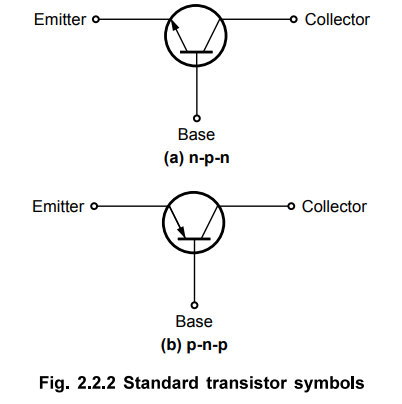Electron Devices and Circuits: Unit II: (a) Bipolar Junction Transistors (BJT)
Structure of pnp and npn Transistors
Bipolar Junction Transistors (BJT)
• The middle region of each transistor type is called the base of the transistor. This region is very thin and lightly doped.
Structure of pnp and npn Transistors
AU
: May-02, 09, 12, Dec.-14
•
When a transistor is formed by sandwiching a single p-region between two
n-regions, as shown in the Fig. 2.2.1 (a), it is an n-p-n type transistor. The
p-n-p type transistor has a single n-region between two p-regions, as shown in
Fig. 2.2.1 (b).

•
The middle region of each transistor type is called the base of the transistor.
This region is very thin and lightly doped.
•
The process by which impurities are added to a pure semiconductor is called
doping.
•
The remaining two regions are called emitter and collector.
•
The emitter and collector are heavily doped. But the doping level in emitter is
slightly greater than that of collector.
•
The collector region-area is slightly more than that of emitter. It helps in
better power dissipation.
Transistor
Symbols
•
Fig. 2.2.2 (a) and (b) shows the symbols of npn and pnp transistors. Arrowhead
on a transistor symbol indicates the conventional current which is opposite to
the direction of electron current in emitter.

Diode
Equivalent Structure of Transistor
•
A transistor can be considered as two p-n junction diodes connected back to
back as shown in Fig. 2.2.3 (a) and (b).

Junctions
of Transistor
•
A transistor has two p-n junctions.
•
One junction is between the emitter and the base and is called the emitter base
junction or simply the emitter junction JE.
•
The other junction is between the base and the collector and is called
collector-base junction or simply collector junction JC.
Cannot
Replace Transistor by Back to Back Diodes
•
However, we cannot replace transistor by back to back connected diodes because
of the following reasons :
1.
Relative doping levels in the base, emitter and collector junctions must be
satisfied to work that device as a transistor. Two normal p-n junction diodes
cannot satisfy this requirement.
2.
In a transistor, emitter to base junction is forward biased while base to
collector junction is reversed biased. But due to diffusion process almost
entire emitter current reaches to collector and base current is negligibly
small. Thus due to diffusion, device works as a transistor. While in back to
back connected diodes there are two separate diodes, one forward biased and one
reverse biased and diffusion cannot take place. Thus maximum series current
which can flow is reverse saturation current of a reverse biased diode. Hence
the combination of back to back connected diodes cannot be used as transistor.
•
Another important point is that, the emitter area in the transistor is
considerably smaller than the collector area. This is because the collector
region has to handle more power than the emitter and more surface area is
required for heat dissipation.
Review Questions
1. Explain the structure of pnp and npn transistors.
2. Why collector region of a transistor is larger in area than
emitter region ?
3. Explain the terms emitter, collector and base.
AU : ECE ; May-12, Marks 3
4. Sketch the symbols of transistors.
AU : ECE : May-12, Marks 3
5. Will a transistor result if two diodes are connected back to
back ?
6. In bipolar junction transistors, mention the heavily doped
and lightly doped regions.
AU ; May-09, Marks 2
7. Explain the construction and operation oF NPN transistor with
neat sketch. Also comment on the characteristics of NPN transistor.
AU : Dec.-14, Marks 16
Electron Devices and Circuits: Unit II: (a) Bipolar Junction Transistors (BJT) : Tag: : Bipolar Junction Transistors (BJT) - Structure of pnp and npn Transistors
Related Topics
Related Subjects
Electron Devices and Circuits
EC3301 3rd Semester EEE Dept | 2021 Regulation | 3rd Semester EEE Dept 2021 Regulation
